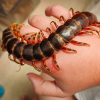I didn't know they go after dandelion 
Quite fascinating how many there were, did they really need that many workers to deal with a small dandelion?
That worker barely reacted, it's like being kept in captivity got them re-wired into thinking "yup, there goes the hand that knows all and sees all, thanks for the food!"
When this colony was very new (2019) and had less than 10 workers, even then they sort of recognized fresh dandelion seeds. Problem was, although one worker recognized the seed, when she brought it into the test tube, her sisters would encounter the fluff end and drag it out as trash. It was pretty funny.... I wish I'd watched more closely the transition where they came to recognize "fluff is connected to food."
>Quite fascinating how many there were, did they really need that many workers to deal with a small dandelion?
No, they don't, but with Veromessor pergandei they travel in huge foraging columns, and if news spreads of food, it triggers masses of workers to try to go foraging. They are phototropic so I also have a video of huge numbers crawling up the outworld wall toward a moving light source.
>That worker barely reacted, it's like being kept in captivity got them re-wired into thinking "yup, there goes the hand that knows all and sees all, thanks for the food!"
Which one? When the breeze comes in upon opening the outworld lid, they definitely all kind of jumped to attention. It was interesting to see it in the video. lol
-
100lols and BleepingBleepers like this
Past & Present
Veromessor pergandei, andrei, stoddardi; Novomessor cockerelli
Camponotus fragilis, Camponotus sansabeanus (inactive), vicinus, laevigatus/quercicola, CA02
Pogonomyrmex subnitidus, P. californicus (inactive)
Liometopum occidentale (inactive); Prenolepis imparis; Myrmecocystus mexicanus (inactive); Tetramorium sp. (inactive); Lasius sp.
Termites: Zootermopsis angusticollis, and a box of drywood termites that can't be seen
Isopods: (most no longer keeping) A. gestroi, granulatum, kluugi, maculatum, vulgare; C. murina; P. hoffmannseggi, P. haasi, P. ornatus; V. parvus, P. pruinosus, T. tomentosa
Spoods: (no longer keeping) Phidippus sp., other
















